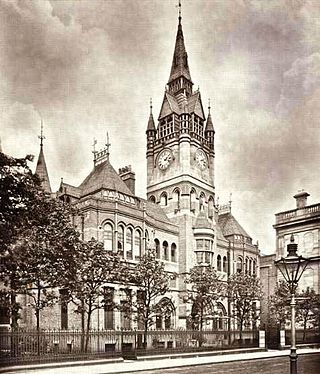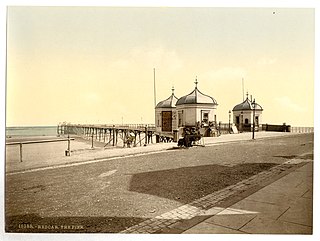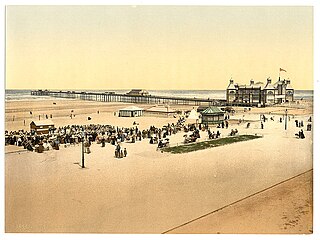
A pier is a raised structure that rises above a body of water and usually juts out from its shore, typically supported by piles or pillars, and provides above-water access to offshore areas. Frequent pier uses include fishing, boat docking and access for both passengers and cargo, and oceanside recreation. Bridges, buildings, and walkways may all be supported by architectural piers. Their open structure allows tides and currents to flow relatively unhindered, whereas the more solid foundations of a quay or the closely spaced piles of a wharf can act as a breakwater, and are consequently more liable to silting. Piers can range in size and complexity from a simple lightweight wooden structure to major structures extended over 1,600 m (5,200 ft). In American English, a pier may be synonymous with a dock.

Lytham St Annes is a seaside town in the Borough of Fylde in Lancashire, England. It is on the Fylde coast, directly south of Blackpool on the Ribble Estuary. The population of the built-up area at the 2021 census was 42,695. The town is made up of the four areas of Lytham, Ansdell, Fairhaven and St Annes-on-the-Sea.

Freckleton is a village and civil parish on the Fylde coast in Lancashire, England, to the south of Kirkham and east of the seaside resort of Lytham St. Annes. In 2001 the parish had a population of 6,045, reducing to 6,019 at the 2011 Census. The village is near Warton, with its links to BAE Systems. Warton Aerodrome's 1.5 miles (2.4 km) runway is partly within Freckleton's boundary. Freckleton has a parish council, and is part of Fylde Borough, and Fylde constituency.

Southport Pier is a pleasure pier in Southport, Merseyside, England. Opened in August 1860, it is the oldest iron pier in the country. Its length of 1,108 m (3,635 ft) makes it the second-longest in Great Britain, after Southend Pier. Although at one time spanning 1,340 m (4,380 ft), a succession of storms and fires during the late 19th and early 20th centuries reduced its length to that of the present day.

North Pier is the most northerly of the three coastal piers in Blackpool, England. Built in the 1860s, it is also the oldest and longest of the three. Although originally intended only as a promenade, competition forced the pier to widen its attractions to include theatres and bars. Unlike Blackpool's other piers, which attracted the working classes with open air dancing and amusements, North Pier catered for the "better-class" market, with orchestra concerts and respectable comedians. Until 2011, it was the only Blackpool pier that consistently charged admission.

Llandudno Pier is a Grade II* listed pier in the seaside resort of Llandudno, North Wales, United Kingdom. At 2,295 feet (700 m), the pier is the longest in Wales and the fifth longest in England and Wales. In 2005, was voted "Pier of the Year 2005" by the members of the National Piers Society.

Paignton Pier is a pleasure pier in the large English seaside resort of Paignton, Devon. It was financed by Arthur Hyde Dendy, a local Paignton barrister and designed by George Soudon Bridgman.

Fleetwood Pier, also known as the Victoria Pier, was a pleasure pier located in the English town of Fleetwood, Lancashire. At 492 feet (150 m) in length, it was one of the shortest piers in the country. It was built in 1910 at the end of the golden age of pier building, and other than a 1957 pier built in Deal, Kent to replace a structure damaged in World War II, it was the last pleasure pier to be built in the United Kingdom. The building was destroyed by fire and demolished in 2008.

Richard Knill Freeman was a British architect who began his career at Derby and moved to Bolton, Lancashire in the late 1860s. His work, in Victorian Gothic style and typically recalling the Decorated Period of later medieval architecture, can be seen in several cities and towns across the north of England. He worked in total on about 140 buildings, of which about half survive in some form.
St. Anne's on the Sea Land and Building Company was formed in 1874 and played an integral part in the development of the new town of St.Anne's on the Sea from 1875. The company had its roots in the Rossendale area and the most significant investor was William John Porritt, a woollen manufacturer from Helmshore. His money contributed to the building of St Anne's and restored confidence in the project after some early problems.

Maxwell and Tuke was an architectural practice in Northwest England, founded in 1857 by James Maxwell in Bury. In 1865 Maxwell was joined in the practice by Charles Tuke, who became a partner two years later. The practice moved its main office to Manchester in 1884. Frank, son of James Maxwell, joined the practice in the later 1880s and became a partner. The two senior partners both died in 1893, and Frank Maxwell continued the practice, maintaining its name as Maxwell and Tuke.

Withernsea Pier was a pier in the town of Withernsea, East Riding of Yorkshire, England. The pier was constructed between 1875 and 1877 to attract daytrippers, but was beset by accidents from the outset. Storms and ship-caused damage led to the pier being closed by 1893, and it was completely dismantled by 1903, leaving only the distinctive castellated pier towers on the seafront, which are still there to this day.

Lytham Pier, a pleasure and working pier, was opened in the seaside town of Lytham, Lancashire, England in 1865, in the face of reservations from local residents. The pier underwent several renovations during the 1890s and early 1900s before being badly damaged by a storm in 1903, during which two barges collided with the structure and split it in two. A fire in 1928 resulted in extensive damage to the pavilion, which was not rebuilt, although the pier itself was reopened several months later. Following a period of decline it was closed to the public shortly before the outbreak of the Second World War. The pier was demolished in 1960 despite the protests of thousands of local residents.

Redcar Pier was a Victorian pleasure and landing pier constructed on The Esplanade in the seaside town of Redcar on the north east coast of Yorkshire, England.

Coatham Pier or Victoria Pier, Coatham, was a pleasure pier built on Newcomen Terrace in the Coatham area of Redcar on the north-east Yorkshire coast.

Central Pier was one of two piers in Morecambe, Lancashire, England. Built during the late 1860s, it was 912 feet (278 m) long and featured a large pier head served by steamboats. Two significant fires occurred during its lifetime, one in 1933 destroying the pavilion then dubbed the "Taj Mahal of the North", and another in 1991, the latter which condemned the pier as unsafe and demolition took place the following year in 1992.

West End Pier was one of two piers in Morecambe, Lancashire, England, built during the late 19th century to an eventual length of 1,800 feet (550 m) long and officially opened on 3 April 1896 by Colonel William Henry Foster MP. The pier was one of the first structures in the town to be installed with electric lighting in 1899.

Rhyl Pier, officially known as the Victoria Pier, was a pleasure pier in the seaside town of Rhyl, Flintshire, and the first to be built in North Wales. Designed by James Brunlees and opened in August 1867 at a length of 2,355 feet (718 m), it was the town's central attraction for the ensuing years. Following dispute and public consultation regarding the location it would be built, the pier was constructed near the centre of the esplanade. The pier's Grand Pavilion, built in 1891, featured the world's largest organ, known as the Grand Jubilee Organ and weighed 25 tonnes.

Scarborough North Pier (1868-1905) was a steamer and promenade pier in North Bay, Scarborough, North Yorkshire, England.

New Brighton Pier was a pleasure and fishing pier in New Brighton, Wallasey in England. It was built during the late 1860s at a length of 600 feet (180 m). During the 19th century, New Brighton had developed into a popular seaside resort for Liverpool's working class visitors.























